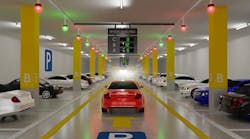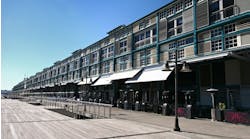Smart cities are coming.
Weaving together the benefits of artificial intelligence (AI), augmented reality (AR), the Internet of Things (IoT), geopositioning, machine learning and more, the cities of the future will be interconnected in ways only science fiction writers have previously imagined. All our appliances will know our habits and tendencies and will automate the drudgery of day-to-day living. Our trips outdoors will be guided and routed to ensure an efficient path. Anywhere we go—schools, hospitals, airports and grocery stores—will be a smart facility as well, with streamlined and convenient experiences.
So, what does all this mean for the minutiae of day-to-day life, such as the details of just getting from place to place? Many believe smart cities will feature expanded public transit options. While that may be true, the COVID-19 pandemic has shown that people in North America continue to value their cars—with car ownership skyrocketing during the pandemic.
As public transit expands and cities begin to prioritize green initiatives, many public parking spaces and lots may be removed, creating a scarcity of parking spaces for those who choose to drive—and looking for parking spaces in crowded downtown is never fun at the best of times.
[Related: Emerging Technology Shaping the Future of Parking]
Implications for Building Owners
For building owners in smart cities, this problem creates a unique opportunity. By providing unused parking spaces for rent to members of the public, property owners can monetize unused assets and add yet another smart feature to their buildings.
Drivers looking for a place to park can download an app that leads them to a nearby building with available spaces near their destination. The driver then pays a rate that can scale according to the volume of people looking for spots at the time and the number of available spaces, and the building’s owners are suddenly profiting off what was once an empty and unused parking space.
Of course, not all the newly unused on-site parking should be used for rentable visitor parking. Smart cities will also be green cities, and any building with available square footage should use some of it to contribute to a healthier and greener experience. As our smart cities become more efficient, we will also lean further into sustainability and use our resources to create more livable and satisfying areas to move through. Weather, heat and moisture measurements can identify ideal spots for indoor gardens or greenhouses and other sorts of urban greening.
But luckily, smart parking can even help with that. The average American spends 17 hours a year searching for parking in urban settings, which amounts to wasted fuel and unnecessary pollution.
[Related: Double Duty: Solving Today’s Open Space Challenges]
Why Embrace Smart Parking?
One benefit of leaning into smart parking is that it is relatively inexpensive in terms of setup and infrastructure. Certain more involved aspects of the smart city could require everything from scanners to satellites to specially constructed buildings and roadways, but smart parking takes no more setup than an app, and potentially sensors and scanners in the available spots.
By just setting aside a few spots and joining a program, building owners can spend a minimum amount on setup to quickly start earning a payout and drawing drivers into their spaces, gaining potential customers. Some buildings may even implement free or cheaper parking for people who visit their stores or otherwise use their facilities using dynamic pricing models.
The image of the smart city is ever evolving as innovations emerge to meet new socio-political and economic conditions. The vision of smart cities once involved few or no personal cars, but COVID-19 has proven that we will still need to account for cars in our futuristic, integrated metropolises.
Thankfully, buildings and facilities with integrated parking spaces can turn those lots into sustainable, efficient rental spaces for drivers looking for a place to park. With simple technological upgrades and enrollment in a technology-forward program, empty space becomes a driver of profits and engagement, drawing new visitors to a building and turning unused assets into a new source of revenue.
About the Author:
Jeremy Zuker is the co-founder of WhereiPark, a technology company that enables multifamily residential and commercial property owners to discover new revenue sources through innovative solutions that leverage unused parking spaces.
Read next: How to Protect Your Parking Structure from Winter Weather Damage



